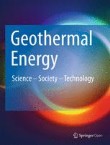Associated Societies
Evaluation of deep geothermal exploration drillings in the crystalline basement of the Fennoscandian Shield Border Zone in south Sweden
The 3.1- and 3.7-km-deep FFC-1 and DGE-1 geothermal explorations wells drilled into the Precambrian crystalline basement on the southern margin of the Fennoscandian Shield are evaluated regarding experiences f...
